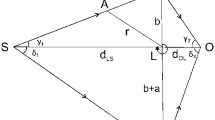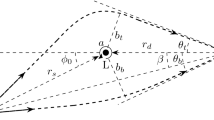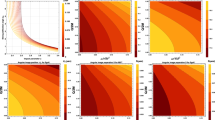Abstract
Modified gravity (MOG) theories are alternatives to general relativity (GR) that arose primarily from the need to explain the observed galactic flat rotation curves without invoking the elusive dark matter hypothesized by GR. A well known MOG is the Scalar–Tensor–Vector–Gravity developed by Moffat, who has also found a spinning solution called the Kerr-MOG black hole (BH) characterized by the spin a and MOG parameter \(\alpha \), the latter determining the strength of the gravitational vector forces. We consider the static-MOG metric (\(a=0\)) to first understand how the nature of geometry drastically changes depending on different sectors of \(\alpha \). Then we study the influence of \(\alpha \) in each sector on a new astrophysical diagnostic caused by frame dragging, viz., the difference \(\varDelta t\) in the times of arrival at the observer of signals emanating from a variable pulsar (PSR) passing behind a Kerr-MOG lens in a PSR-BH binary system. The study generalizes the zeroth order Laguna–Wolszczan formula up to third PPN order in \(\left( 1/r\right) \) using thin-lens approximation, which reveals how \(\varDelta t\) is influenced both by a and \(\alpha \). The magnitude and sign of \(\alpha \) indicate deviations from GR (\(\alpha =0\)) and future measurements may constrain \(\alpha \) provided a suitable binary is identified.

Similar content being viewed by others
Notes
The analogy is loose because the light rays do not travel in vacuum but in the weak gravitational field. For a true gravitational Bohm–Aharonov effect, see [26].
References
Oort, J.: Some problems concerning the distribution of luminosities and peculiar velocities of extragalactic nebulae. Bull. Astron. Inst. Neth. 6, 155 (1931)
Riess, A.G., et al.: Observational evidence from supernovae for an accelerating universe and a cosmological constant. Astron. J. 116, 1009 (1998)
Perlmutter, S., et al.: Discovery of a supernova explosion at half the age of the Universe. Nature (London) 391, 51 (1998)
Agnese, R., et al.: (SuperCDMS Collaboration): search for low-mass weakly interacting massive particles with SuperCDMS. Phys. Rev. Lett. 112, 241302 (2014)
Mannheim, P.D., O’Brien, J.G.: Impact of a global quadratic potential on galactic rotation curves. Phys. Rev. Lett. 106, 121101 (2011)
Nandi, K.K., Bhadra, A.: Comment on “Impact of a Global Quadratic Potential on Galactic Rotation Curves”. Phys. Rev. Lett. 109, 079001 (2012)
Milgrom, M.: A modification of the Newtonian dynamics as a possible alternative to the hidden mass hypothesis. Astrophys. J. 270, 365 (1983)
Nojiri, S., Odintsov, S.D.: Modified \(f(R)\) gravity consistent with realistic cosmology: from a matter dominated epoch to a dark energy universe. Phys. Rev. D 74, 086005 (2006)
Moffat, J.W.: Scalar–tensor–vector gravity theory. J. Cosmol. Astropart. Phys. 03, 004 (2006)
Izmailov, R.N., et al.: Modified gravity black hole lensing observables in weak and strong field of gravity. Mon. Not. R. Astron. Soc. 483, 3754 (2019)
Brownstein, J.R., Moffat, J.W.: Galaxy rotation curves without nonbaryonic dark matter. Astrophys. J. 636, 721 (2006)
Brownstein, J.R., Moffat, J.W.: Galaxy cluster masses without non-baryonic dark matter. Mon. Not. R. Astron. Soc. 367, 527 (2006)
Moffat, J.W., Rahvar, S.: The MOG weak field approximation and observational test of galaxy rotation curves. Mon. Not. R. Astron. Soc. 436, 1439 (2013)
Pérez, D., Armengol, F.G.L., Romero, G.E.: Accretion disks around black holes in scalar–tensor–vector gravity. Phys. Rev. D 95, 104047 (2017)
Lopez Armengol, F.G., Romero, G.E.: Neutron stars in scalar–tensor–vector gravity. Gen. Relativ. Gravit. 49, 27 (2017)
Brownstein, J.R., Moffat, J.W.: The Bullet Cluster 1E0657-558 evidence shows modified gravity in the absence of dark matter. Mon. Not. R. Astron. Soc. 382, 29 (2007)
Moffat, J.W., Toth, V.T.: Testing Modified Gravity with Globular Cluster Velocity Dispersions. Astrophys. J. 680, 1158 (2008)
Moffat, J.W., Toth, V.T.: Cosmological observations in a modified theory of gravity (MOG). Galaxies 1, 65 (2013)
Moffat, J.W., Toth, V.T.: Rotational velocity curves in the Milky Way as a test of modified gravity. Phys. Rev. D 91, 043004 (2015)
Moffat, J.W., Rahvar, S.: The MOG weak field approximation: II. Observational test of Chandra X-ray clusters. Mon. Not. R. Astron. Soc. 441, 3724 (2014)
Moffat, J.W.: Black holes in modified gravity (MOG). Eur. Phys. J. C 75, 175 (2015)
Moffat, J.W.: Modified gravity black holes and their observable shadows. Eur. Phys. J. C 75, 130 (2015)
Bhadra, A., Nandi, K.K.: Gravitational time advancement and its possible detection. Gen. Relat. Grav. 42, 293 (2010)
Deng, X.-M., Xie, Y.: Gravitational time advancement under gravity’s rainbow. Phys. Lett. B 772, 152 (2017)
Ghosh, S., Bhadra, A.: Influences of dark energy and dark matter on gravitational time advancement. Eur. Phys. J. C 75, 494 (2015)
Ford, L.H., Vilenkin, A.: A gravitational analogue of the Aharonov–Bohm effect. J. Phys. A Math. Gen. 14, 2353 (1981)
Laguna, P., Wolszczan, A.: Pulse arrival times from binary pulsars with rotating black hole companions. Astrophys. J. 486, L27 (1997)
Datta, B., Kapoor, R.C.: General relativistic effects on the pulse profile of fast pulsars. Nature 315, 557 (1985)
Matilsky, T., Shräder, C., Tananbaum, H.: Evidence for 200 second variability in the X-ray flux of the quasar 1525 + 227. Astrophys. J. 258, L1 (1982)
Izmailov, R.N., et al.: Relative time delay in a spinning black hole as a diagnostic for no-hair theorem. Eur. Phys. J. C 79, 105 (2019)
Penrose, R.: Gravitional collapse: the role of general relativity. Riv. Nuovo Cimento 1, 252 (1969)
Izmailov, R.N., Karimov, RKh, Potapov, A.A., Nandi, K.K.: String effect on the relative time delay in the Kerr–Sen black hole. Ann. Phys. 413, 168069 (2020)
Karimov, RKh, Izmailov, R.N., Potapov, A.A., Nandi, K.K.: Terrestrial Sagnac delay constraining modified gravity models. Gen. Relativ. Gravit. 50, 44 (2018)
Hartle, J.B.: Gravity: An Introduction to Elnstein’s General Relativity. Pearson Inc., San Francisco (2003)
Manko, V.S., Novikov, I.D.: Generalizations of the Kerr and Kerr–Newman metrics possessing an arbitrary set of mass-multipole moments. Class. Quantum Grav. 9, 2477 (1992)
Glampedakis, K., Babak, S.: Mapping spacetimes with LISA: inspiral of a test body in a ‘quasi-Kerr’ field. Class. Quantum Grav. 23, 4167 (2006)
Dadhich, N., Maartens, R., Papadopoulos, P., Rezania, V.: Black holes on the brane. Phys. Lett. B 487, 1 (2000)
Keeton, C.R., Petters, A.O.: Formalism for testing theories of gravity using lensing by compact objects. II. Probing post-post-Newtonian metrics. Phys. Rev. D 73, 044024 (2006)
Nandi, K.K., et al.: Features of galactic halo in a brane world model and observationalconstraints. Mon. Not. R. Astron. Soc. 399, 2079 (2009)
Boyer, R.H., Lindquist, R.W.: Maximal analytic extension of the Kerr Metric. J. Math. Phys. 8, 265 (1967)
Dymnikova, I.G.: Motion of particles and photons in the gravitational field of a rotating body (In memory of Vladimir Afanas’evich Ruban). Sov. Phys. Uspekhi 29, 215 (1986)
Bozza, V.: Gravitational lensing in the strong field limit. Phys. Rev. D 66, 103001 (2002)
Sasaki, M., Shiromizu, T., Maeda, K-i: Gravity, stability, and energy conservation on the Randall–Sundrum brane world. Phys. Rev. D 62, 024008 (2000)
Lipunov, V.M., Bogomazov, A.I., Abubekerov, M.K.: How abundant is the population of binary radio pulsars with black holes? Mon. Not. R. Astron. Soc. 359, 1517 (2005)
Gou, L., et al.: The extreme spin of the black hole in Cygnus X-1. Astrophys. J. 742, 85 (2011)
Pfahl, E., Loeb, A.: Probing the spacetime around Sagittarius A* with radio pulsars. Astrophys. J. 615, 253 (2004)
Faucher-Giguère, C.A., Loeb, A.: Pulsar-black hole binaries in the Galactic Centre. Mon. Not. R. Astron. Soc. 415, 3951 (2011)
Kato, Y., Miyoshi, M., Takahashi, R., Negoro, H., Matsumoto, R.: Measuring spin of a supermassive black hole at the Galactic centre—implications for a unique spin. Mon. Not. R. Astron. Soc. 403, L74 (2010)
Van Straten, W., et al.: A test of general relativity from the three-dimensional orbital geometry of a binary pulsar. Nature (London) 412, 158 (2001)
Acknowledgements
The reported study was funded by RFBR according to the research Project No. 18-32-00377.
Author information
Authors and Affiliations
Corresponding author
Additional information
Publisher's Note
Springer Nature remains neutral with regard to jurisdictional claims in published maps and institutional affiliations.
Rights and permissions
About this article
Cite this article
Tuleganova, G.Y., Izmailov, R.N., Karimov, R.K. et al. Times of arrival (TOA) of signals in the Kerr-MOG black hole. Gen Relativ Gravit 52, 31 (2020). https://doi.org/10.1007/s10714-020-02684-0
Received:
Accepted:
Published:
DOI: https://doi.org/10.1007/s10714-020-02684-0




